Units Overseas Tour: Germany
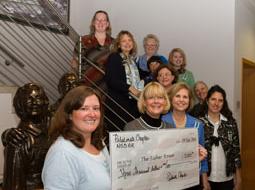
We left Vienna on October 26, 2014 and flew to Frankfurt where Palatinate Chapter Regent Cary Costa and Associate Member Ransom Schwerzler were patiently waiting for our delayed flight. Speeding along on the Autobahn, we arrived in Landstuhl about 1 hour, 15 minutes later. We enjoyed seeing the many vineyards, farms, beautiful scenery and fall colors of the southwest Germany region. DAR Project Patriot Chair Jennifer Minus met us at the Schlosshotel in Landstuhl where we quickly changed for dinner at Burg Lichtenberg Castle, built around 1200. We enjoyed a delicious dinner and visiting with the members and guests.
The chapter generously supports Landstuhl and the Fisher Houses so the next morning we visited one of the two Fisher Houses located on the base at Landstuhl. They were delighted to receive baskets of homemade muffins made by the Associate Member De Williamson, whose husband works at Landstuhl Regional Medical Center. Cary presented a chapter check to the Assistant Director, Doria, who shared with us that these houses host an average of 130 patients and their families every month.
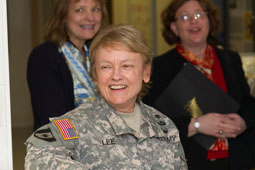 We continued on to the Medical Center where we were welcomed by Col. Judith Lee who gave us an excellent tour of the Medical Center which opened in 1953. Col. Lee is quite familiar with the DAR, having received the Anita Newcomb McGee Award at Continental Congress in 2010.
We continued on to the Medical Center where we were welcomed by Col. Judith Lee who gave us an excellent tour of the Medical Center which opened in 1953. Col. Lee is quite familiar with the DAR, having received the Anita Newcomb McGee Award at Continental Congress in 2010.
The Landstuhl Regional Medical Center is the largest American hospital outside the United States, providing care for more than 52,000 local American military personnel and their families. It also provides specialized care for the more than 250,000 additional American military personnel and their families in the European Theater. Landstuhl served as the primary medical treatment center for injuries during Operations Desert Shield and Storm, but the facility has also treated non-military personnel injuries, including embassy personnel. Today, LRMC provides medical treatment to those injured during Operation Enduring Freedom in Afghanistan. We were relieved to hear that there are far fewer traumatic injuries due to the troop withdrawal.
We toured the ICU, the Neonatal ICU, and visited with several wounded warriors. Hospices as we know them do not exist in Germany, and the Fisher Foundation recently helped fund the Meehan Room to serve as a hospice room. It was an attractive room with a Quilt of Valor on the bed.
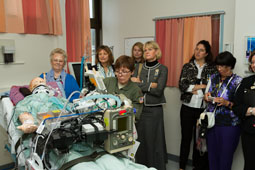 We were given a demonstration of the simulation model by Major Cheryl Lockhart of the Critical Care Air Transport Team. The CCATT is used to pick up patients down range, return them to Landstuhl for emergency treatment and then transport them to the U.S. when they are stable, typically within 72 hours. It was reassuring to know that the men and women serving our country in harm’s way receive the best possible emergency care. Major Lockhart explained that patients arriving today have a better attitude than those from a few years ago as they know they will receive excellent post-surgical care and rehab. The Medical Center has a 95% survival rate for patients and most are able to Skype with their family shortly after arrival.
We were given a demonstration of the simulation model by Major Cheryl Lockhart of the Critical Care Air Transport Team. The CCATT is used to pick up patients down range, return them to Landstuhl for emergency treatment and then transport them to the U.S. when they are stable, typically within 72 hours. It was reassuring to know that the men and women serving our country in harm’s way receive the best possible emergency care. Major Lockhart explained that patients arriving today have a better attitude than those from a few years ago as they know they will receive excellent post-surgical care and rehab. The Medical Center has a 95% survival rate for patients and most are able to Skype with their family shortly after arrival.
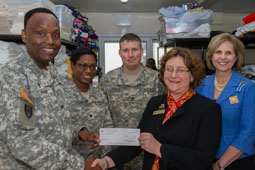 Hospital Chaplain Sherman W. Baker, Jr. showed us the temporary Chaplain’s Closet which has been generously supported by our members through the DAR Project Patriot Committee. The Chaplain greets every arriving patient and offers clothes, iTune cards or phone cards. Once members heard that we would be at Landstuhl, they began sending iTunes cards to Jenn for distribution and she collected almost 150 cards worth over $2,000 within just a few days. Each patient we greeted received cards and the extras were left with Chaplain Baker. Chaplain Baker was thrilled to receive a check in the amount of $25,000 from NSDAR.
Hospital Chaplain Sherman W. Baker, Jr. showed us the temporary Chaplain’s Closet which has been generously supported by our members through the DAR Project Patriot Committee. The Chaplain greets every arriving patient and offers clothes, iTune cards or phone cards. Once members heard that we would be at Landstuhl, they began sending iTunes cards to Jenn for distribution and she collected almost 150 cards worth over $2,000 within just a few days. Each patient we greeted received cards and the extras were left with Chaplain Baker. Chaplain Baker was thrilled to receive a check in the amount of $25,000 from NSDAR.
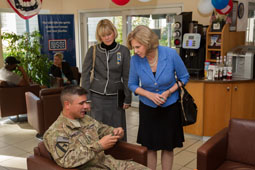 We had lunch in the dining room where it was a pleasure to administer the Oath of membership to Laurie Kane, a brand new member and Landstuhl employee. After lunch we toured the USO – Wounded Warrior center where recovering warriors have an opportunity to relax, socialize and interact with other patients.
We had lunch in the dining room where it was a pleasure to administer the Oath of membership to Laurie Kane, a brand new member and Landstuhl employee. After lunch we toured the USO – Wounded Warrior center where recovering warriors have an opportunity to relax, socialize and interact with other patients.
Returning to the Schlosshotel for the evening, our dinner featured speaker Dr. Roland Paul, Director of Institute of Palatinate History and Folklore, who talked of the immigration of Palatinates to America. When unrest and crop failures plagued the Palatinates in the early 18th century, Queen Anne of England invited Protestants to settle in her colonies in the New World, with free travel and promise of land. Over 12,000 Palatinates responded, many of them Mennonites and Amish, settling in Pennsylvania, New York and Virginia. The first permanent German settlement in America was Germantown, PA. Noting my maiden name, Dr. Paul surprised me with information regarding the Fortney/Fordney families which were among the immigrants to Pennsylvania from the Palatinate region.
It was fascinating to hear that over 1100 members of the Régiment Royal Deux-Ponts, commanded by Christian Von Forbach and his brother Wilhelm, sailed to Newport, Rhode Island in 1781 where they joined the French under the command of Comte de Rochambeau. They participated valiantly in the Battle of Yorktown in support of the Colonies’ fight for independence and they were present when Lord Cornwallis surrendered to General George Washington.
 The next morning we drove to Zweibrücken (Two Bridges) for a walking tour led by Herr Orth. Herr Orth shared with us that he lived in California after the War and his English teacher was a DAR member who invited him to speak to the Naturalization ceremonies in which her chapter participated. We stopped briefly in the palace before climbing 200 feet to the top of the bell tower of Alexander's Church, founded in 1493, which afforded a lovely view of the area.
The next morning we drove to Zweibrücken (Two Bridges) for a walking tour led by Herr Orth. Herr Orth shared with us that he lived in California after the War and his English teacher was a DAR member who invited him to speak to the Naturalization ceremonies in which her chapter participated. We stopped briefly in the palace before climbing 200 feet to the top of the bell tower of Alexander's Church, founded in 1493, which afforded a lovely view of the area.
We walked to the Rosengarten (rose garden) which was inaugurated by Princess Hildegard of Bavaria in June 1914, the last prominent social event before the First World War. It was a beautiful garden to visit and we could only imagine how stunning it is when the 45,000 roses are in bloom. In the garden is a marker honoring the Régiment Deux-Ponts and Ransom conducted a lovely ceremony of remembrance while Cary and I placed a wreath.
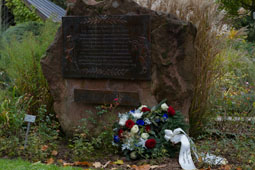 Our lunch at the Rose Garden Hotel featured speaker Herr Friedrich of Hamburg who enthusiastically shared many of the Palatinate connections to America. Herr Friedrich recently made his first visit to Washington, D.C. and immediately began walking in search of the Octagon House. The first building he saw was an impressive marble building with stately columns, and he said as he stood there touching the columns and reading the names of the original 13 colonies, he realized he was standing at the headquarters of NSDAR.
Our lunch at the Rose Garden Hotel featured speaker Herr Friedrich of Hamburg who enthusiastically shared many of the Palatinate connections to America. Herr Friedrich recently made his first visit to Washington, D.C. and immediately began walking in search of the Octagon House. The first building he saw was an impressive marble building with stately columns, and he said as he stood there touching the columns and reading the names of the original 13 colonies, he realized he was standing at the headquarters of NSDAR.
Our last visit was to Bioland which was founded in 1971 and features a farmer’s market and organically raised meat and poultry, across the road from the base in Wiesbaden. We had a delicious soup dinner in the restaurant before continuing to our final hotel near the Frankfurt airport.
 The Palatinate Chapter was organized in Ramstein in 2000 and now has 38 members and 300 associate members. The resident members are spread across Germany and many either serve in the military or as civilians. Most live in the Kaiserslautern Military Community, which consists of the Ramstein Air Base and Landstuhl Regional Medical Center. The chapter hosts the Zweibruecken C.A.R. Society which often meets by Skype.
The Palatinate Chapter was organized in Ramstein in 2000 and now has 38 members and 300 associate members. The resident members are spread across Germany and many either serve in the military or as civilians. Most live in the Kaiserslautern Military Community, which consists of the Ramstein Air Base and Landstuhl Regional Medical Center. The chapter hosts the Zweibruecken C.A.R. Society which often meets by Skype.
Palatinate Chapter lays a wreath each spring in observance of Yorktown Day, on the gravesite of Wilhelm and Christian von Forbach, who are entombed in Munich, in honor of the Palatinate Patriots who served in the war for American Independence. Chapter members attend the international ceremony in Hochfelden, France and lay a wreath at the monument marking the gravesite of WWII veteran Lt. John Grant Rahill, who was killed in France in December, 1944.
Our trip was an amazing experience and I am deeply grateful to each of the chapter Regents, Virginia Lingelbach, and Lee Thorson in the Office of the President General for their extraordinary work to coordinate the trip to seven countries. Steve took hundreds of photos and we will cherish the memories and the friends we made. After a long flight back to Houston on October 29th, we truly appreciated being in our own home for first time in six weeks.


 Today's DAR
Today's DAR